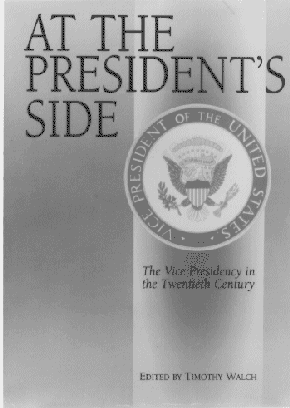
The Record - January 1998
New Book Tells the Story of the Vice Presidency, The Nation's "Most Insignificant Office"
This nation's first vice president, John Adams, called his job "the most insignificant office ever the invention of man contrived or his imagination conceived." And many of the forty-three men who succeeded him in the office have said much worse.

A new book from the Hoover Library and the University of Missouri Press tells the story of "that most insignificant office." At the President's Side: The Vice Presidency in the Twentieth Century traces the evolution of the vice presidency in the twentieth century from Theodore Roosevelt to Dan Quayle.
The first five chapters tell the stories of a colorful collection of characters chosen for their native states or their political acumen, but not for their leadership abilities. Few Americans remember "Sunny Jim" Sherman or Charles Curtis among other vice presidents from the first half of the century.
The next four chapters form a mosaic of tragedy. Richard Nixon and Lyndon Johnson rose from the vice presidency to the presidency only to be forced from office. Hubert Humphrey was humiliated as vice president by a man who should have known better. And Spiro Agnew was routed from the office by petty greed.
The four chapters after that tell the story of a new vice presidency. Nelson Rockefeller, Walter Mondale, George Bush, and Dan Quayle redefined the job that not many people wanted, but that few could refuse. Dan Quayle's own essay is particularly valuable because he reflects on the checkered past of his predecessors, gives credit to Walter Mondale for rehabilitating the vice presidency, and tells of his working relationshipwith George Bush.
But what of the future of this "insignificant office?" In an provocative essay, Professor Richard Neustadt of Harvard University provides a detailed analysis of the nucleus of vice presidential power proximity to the president. We have Neustadt's maxim: "The power and influence of a vice president is inversely proportional to the political distance between that vice president and his president. The greater the distance the less the power." A panel of experts heartily concurred.
Edited by Timothy Walch, director of the Herbert Hoover Presidential Library, At the President's Side includes essays by presidential scholars John M. Cooper, Robert H. Ferrell, Elliot Rosen, Richard S. Kirkendall, Richard Norton Smith, Robert Dallek, Joel Goldstein, John Robert Greene, and Steven M. Gillon. Also included are incisive commentaries by Washington insiders such as Hugh Sidey, R.W. Apple, James Cannon, and Chase Untermeyer, along with remarks by Professor Neustadt and Vice President Quayle.
The book is the result of a popular conference on this topic held at the Hoover Library in October 1995 and broadcast on C-SPAN. Consult the University of Missouri Press online at http://www.system.missouri.edu/press for more information. At the President's Side is available in the Museum Store at the Hoover Library and directly from the University of Missouri Press. To order call: 1-800-828-1894.